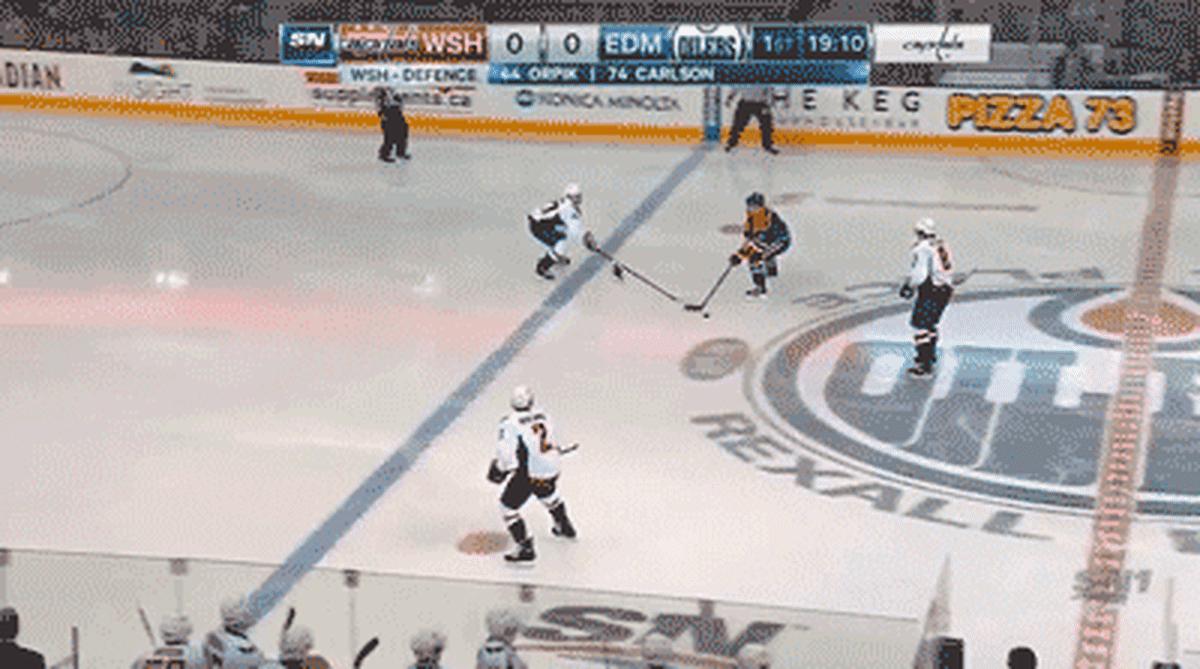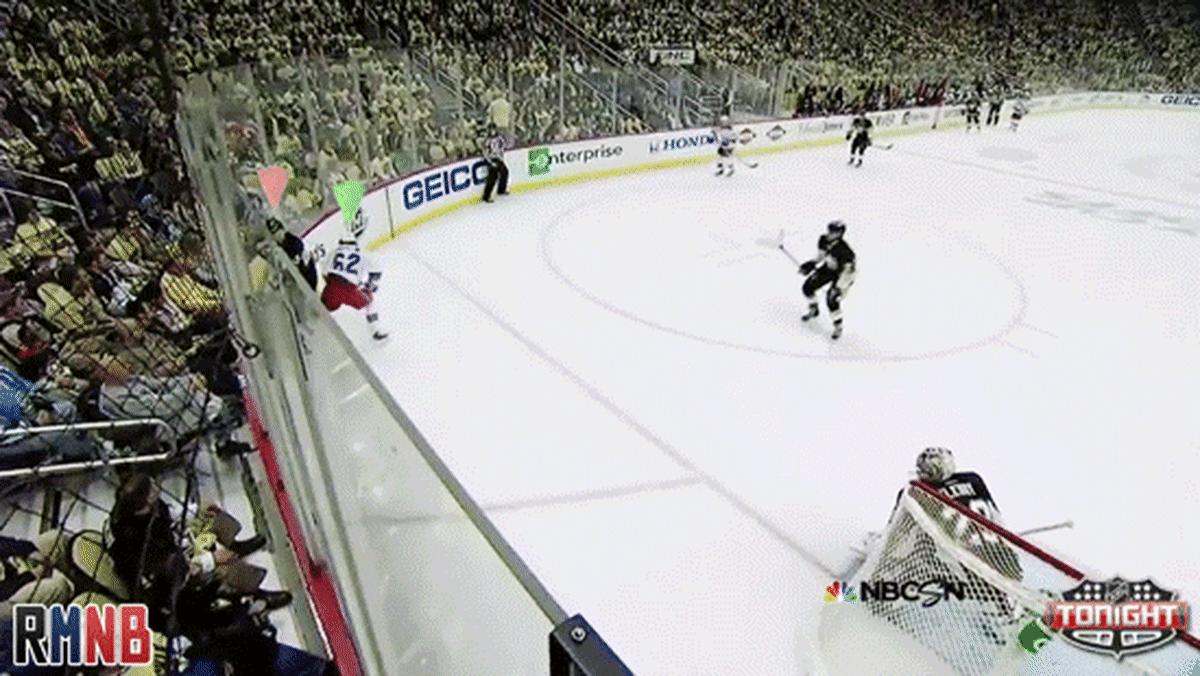Eye Test: Making sense of Alex Ovechkin, "The Great -35"

As Alex Ovechkin’s plus/minus rating plummeted last season (eventually landing at –35), a debate raged: Was the star’s defensive effort horrendous, or were his bad stats a fluke?
Well I’m here to tell you the answer, and that answer is ... maybe both?
Hi and welcome back to “Eye Test,” a weekly post for which I watch a game featuring a player about whom statistically-inclined fans and watch-the-games-you-nerd-type fans often disagree. Last time we talked about the Maple Leafs’ Cody Franson. Today, we turn a beady eye on the Great Eight, who is still being argued about with great enthusiasm as he battles his way through the first five-game scoreless drought of his career.
Fancy Stats Primer: Your guide to hockey's advanced analytics jargon
It was surprising how often last season the debate about the Capitals’ star did not progress beyond “Ovechkin doesn’t try on defense” versus “Ovechkin’s PDO (team shooting percentage plus save percentage when a given player is on the ice) explains his Corsi away.” Washington’s goalies (Braden Holtby, Philipp Grubauer, Jaroslav Halak and Michal Neuvirth) had a combined .898 save percentage with Ovechkin on the ice last season. Yes, that number was a fluke and it almost entirely explains his plus-minus ratio.
But is it really so inconceivable that a guy who gets 350 shots on goal in a down year could outshoot his opponents at even strength and still not care at all about checking? In their defense of statistics, did fans accidentally defend a player who maybe deserves a little heat?
For his part, Ovechkin’s new coach, Barry Trotz, seems pleased with his star’s efforts. Half the hockey world expected the defensive-minded Trotz, whose previous employer wouldn't even draft a Russian player until after he left, to clash with his captain. For that reason, many take his apparent happiness with Ovechkin’s game as tacit endorsement of the winger’s defensive play.
• Trotz: Ovechkin “playing the right way” despite scoring drought
I am skeptical. With the Predators, Trotz had shown a willingness to accept some “necessary evils” (e.g. Jason Arnott) for the sake of offense. He featured Ovechkin's Olympic teammate Alex Radulov prominently even as a rookie, going to great lengths to shelter him. And Trotz has certainly never coached an offensive weapon of Ovi's caliber. Short of his meeting up with Andrei Kostitsyn for a nightcap, Ovechkin is probably at no risk of visting the press box as a healthy scratch.
To test the validity of my gut feeling about Ovechkin's defensive play, I watched the Caps’ Oct. 22 game against the Oilers, a defensive challenge (if not an overall challenge) for almost anybody. Our subject ended up with a +19 Corsi rating but a –1 on the score sheet, so it seemed like as good a game as any to watch.
Right from the first shift, I see it. I see the offense, the defense, and the disconnect. Just look at how his first shift ends:

If the Washington defensemen had managed to blow that 1-on-2, or Edmonton’s forecheck had a forced Matt Niskanen to turn that puck over on the zone exit, we’d be looking at another “controller disconnected” GIF like this one:
But Ovechkin did nothing wrong! His charging from the back end wouldn't have made a difference on that Taylor Hall-against-the-world play—it probably would have just meant a penalty. And he does look back twice to make sure that the Capitals have the puck en route to an exit before he hits the bench.
But the aesthetics are terrible. Ovechkin plays in quick bursts of speed. He's always either going 100 miles per hour or drifting as if he's waiting for gentle breeze to push him forward. He's not a perpetual motion machine like his rival, Sidney Crosby. The Penguins’ captain moves at a remarkably consistent speed, which makes him so amazing ... and so much less fun to watch. It's also why GIFs like this one, made by defensive Washington fans, don't pack the same punch:

But as I watched Ovechkin closely for an entire game, and not just in the five-second interval of a hilarious GIF, I realized that he also plays this way on offense. Stop. Start. Stop Start. When he stops, he really stops, and it can look like someone unplugged his controller. But when he's really needed on the backcheck, he can really start again:

And what about that –1? The goal was arguably his fault (the puck bounced) but it certainly couldn't be pinned on his effort to get back:

Ovechkin only got two shots on goal against the Oilers, and barely even attempted one until the second period. Still, the Caps outshot Edmonton by nearly 20 with him on the ice. His defensive effort was fine. Barry Trotz's systems have always hinged more on personal responsibility and the forwards' willingness to help the defensemen than on any particular complex mechanism. Ovechkin got back, battled and kept his bearings in his own zone. No one will mistake the guy for Patrice Bergeron, but who cares? He's fine.
Tom Wilson rejoins Capitals eager to prove he's ready
Believe it or not, Ovechkin and Franson, the first subject of my Eye Test, seem to have a common problem. They’re unusual in a way that allows people to project “bad” upon them. Just as Franson appears to be the only puck-moving defenseman to make a living entirely off the stretch pass, Ovechkin might be the only speedy goal-scorer who plays in such deliberate bursts. He glides in a totally upright position, waits for an opportunity, then crouches and accelerates from practically a stand-still. Every player skates this way to an extent, but no one goes from ankles locked together to practically licking the ice the way Ovechkin does.
To my eyes, Ovechkin’s bursts come in roughly equal measure on offense and defense, which leaves his critics to basically argue that he should skate at his top speed all the time. No one would argue that, and it underscores another issue here: The times when he looks completely disengaged could very well enable what makes him so great.
Baseball fans always lamented Adam Dunn’s strikeouts. He had so much power—462 career home runs—that it seemed that if he could only cut down on his misses, he would be one of the best hitters in baseball. But that ignores what the player is physically doing. Adam Dunn swinging his bat like a golf club caused the dingers and the strikeouts.
I’m not giving Ovechkin a pass on defense because he scores a lot. But if you want him to empty the tank on defensive plays that he likely can't make a difference on—all in the name of pleasing your ideas of how a backchecker should look—don't be surprised if he can’t skate when the puck goes the other way.
